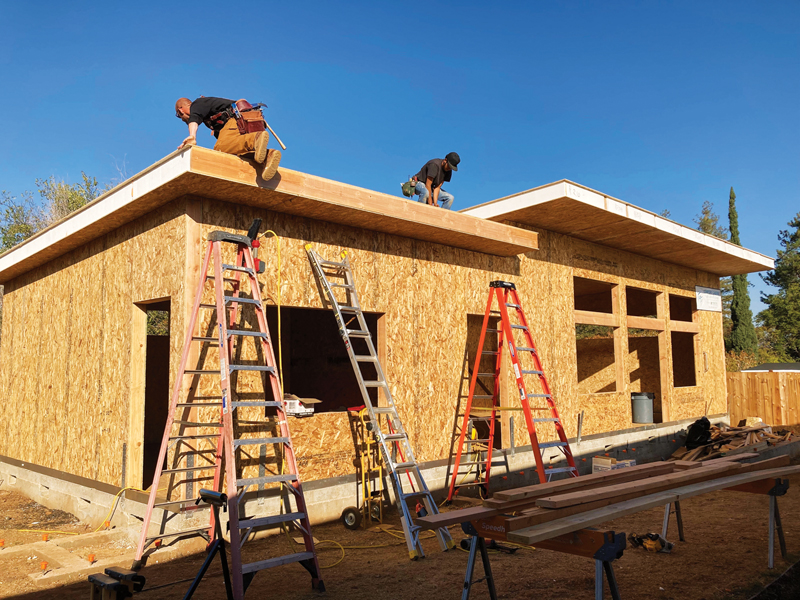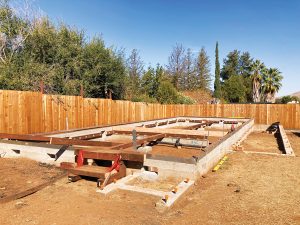Modular ADUs can help ease state housing crisis

CONTRA COSTA COUNTY, CA (Jan. 18, 2023) — As cities grapple with the state’s new housing mandates, Accessory Dwelling Units (ADUs) are becoming increasingly more important.
To help speed up the process, Pleasant Hill-based Comfort Casitas uses SIP – structurally integrated panels – to build small, modular homes in residential backyards.
Robert Burtt opted for Comfort Casitas’ program because of the promise of quick permit approval, fewer materials and a shorter construction time. And, he wasn’t disappointed.
He just loves the three-bedroom, two-bath, 1,000 sq. ft. dwelling that popped up in his Walnut Creek backyard in a week’s time. “It’s really cool,” he said enthusiastically, despite being under the weather during a year-end interview.
“The entire thing has vaulted ceilings, so it feels much bigger,” he reported. “The idea was to have the space to rent out or have the parents stay in it – just have flexibility with the property.”
Increased energy efficiency
Gwen Bertolami, who runs Bertolami Engineering and Comfort Casitas, has already completed three ADUs locally with SIP products.
“It’s made in the United States, and it’s incredibly easy to work with,” said Bertolami, who describes the panels as “basically a plywood sandwich with Styrofoam cup material in between.”
Becky Susan of Premier Building Systems offers a more technical description, saying that customers can choose standard expanded polystyrene (EPS) or higher R-Value graphite-enhanced polystyrene (GPS) insulation cores. They are processed with steam instead of the chemicals used in other foam insulations.
“The final product is 90 percent air and has virtually no VOCs (volatile organic compounds) or off-gassing of harmful contaminants into the ozone,” states the website of the Puyallup, Wash., based Premier.
The company also says the products are more energy-efficient than stick framing, and Burtt concurs.
“My first utility bill was $26. And the second month was about $50,” he said, comparing that to $300-$400 a month for his 1,600 sq. ft. main house.
“It has a slab floor, so it should actually be less energy-efficient. But even with that, it’s just that much more efficient. We need the heater at nights maybe for an hour or two,” he added.
Simple construction process

Bob Pastor, owner/contractor for JML Construction Services, used SIP for the first time to build an 884 sq. ft. ADU in a Clayton backyard this fall.
He explained that all the pieces for the exterior walls, roof and floors arrived in panels that are 4-6 feet wide and up to 24 feet long. “Some we can hand carry; others we need equipment to set it up,” he said. “All the panels are numbered and correspond with the drawings. We construct it like an Erector set.”
“When we get the building material for a house, it’s all cut to exactly what you need so the amount of waste that’s created is super-tiny compared to the waste when you do wood frame construction,” Bertolami noted.
Before the Clayton build, the JML crew trained at the Walnut Creek site to learn about the process. “But we weren’t really sure how tough it would be to man-handle these into place. Everything fit, so we were pretty impressed. It went a lot smoother than we anticipated,” he said, adding that he was certain they could construct even faster in the future.
ADUs part of long-term planning
Pastor, a long-time Clayton resident, has built modular “man camps” in remote areas of Africa and Eurasia where there isn’t access to a lot of materials. So, it’s easy for him to understand the need for ADUs made with SIP.
“It’s a good plug-in to the problem with housing,” he said. “It’s a good component as far as the requirements that each municipality has for affordable housing – and you can build on existing properties.”
Clayton has seen a small increase in ADU requests in recent years, with five approved in 2022, three in ’21 and two in ’20. According to Community Development Director Dana Ayers, the city handles most ADUs through an administrative process as required by state law. That means most applicants don’t have to go before the Planning Commission.
“And, they have additional flexibility in regard to setbacks from property lines, more flexibility than what is in city ordinances for a typical single-family home,” Ayers said, adding that the city is using state grant money to implement a program of preapproved ADU plans to make approval even easier.
“Community members who have participated in the Housing Element update have spoken favorably for ADUs,” Ayers told the Pioneer. “We are factoring them into our regional housing needs for the city.”
For his part, Burtt was pleased with the process from beginning to end. He especially praised Bertolami’s efforts. “She’s not in it for profit – she’s in it for everyone’s well-being. And that really shows.”
For more information, visit comfortcasitas.com or sips.premierbuildingsystems.com.

Bev Britton
Bev Britton graduated with a degree in journalism from the University of North Dakota and moved to the Bay Area with her soon-to-be husband Jim in 1986. She was features editor at the Contra Costa Times in Walnut Creek before becoming managing editor of the Contra Costa Sun in Lafayette in 1995. She retired from newsrooms in 2001, but an ad for the Clayton Pioneer drew her back in. The family moved to Lake Wildwood in the Gold Country a few years ago - but working at the Pioneer keeps her in touch with her old neighborhoods in Concord and Clayton.
